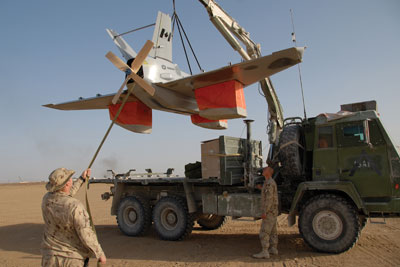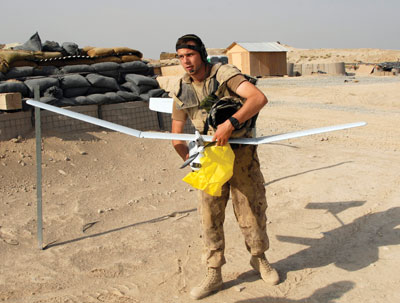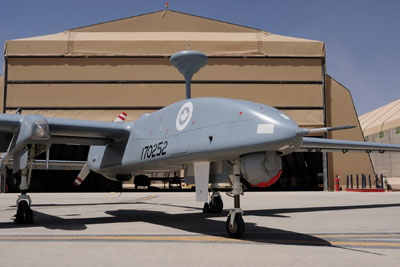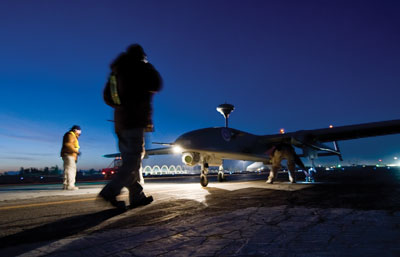
Features
Operations
The wild new frontier
Drone, Unmanned Aerial Vehicle (UAV), Unmanned Aerial System (UAS), Remotely Piloted Aircraft (RPA) or even Pilot-Optional.
September 26, 2011 By Paul Dixon
Drone, Unmanned Aerial Vehicle (UAV), Unmanned Aerial System (UAS), Remotely Piloted Aircraft (RPA) or even Pilot-Optional. What’s in a name? It’s the future calling, where the second century of powered flight promises to be as innovative and exciting as the first hundred years.
 |
|
| Gunner Eric Green (left) and Bombardier Carl Hethrington load the CU-161 Sperwer onto their 10-ton truck after its flight west of Kandahar. Photo: Cpl. Simon Duchesne, photographer, Afg HQ, Roto 9 |
The market for UAVs outside the military is limited at present, but the future seems as big as the sky itself. Once the stuff of science fiction and futurists, a host of aerial vehicles are poised to fly higher and faster or even lower and slower, without a human presence in the cockpit, or even a cockpit. From mini-flyers that barely cover the palm of your hand to solar-powered flyers at stratospheric heights, unmanned aviation is a bit of a wild frontier for aerospace.
Unlike conventional aircraft, UAVs can exceed the operational parameters of crewed missions, such as dangerous low-level operations and extended missions where human fatigue becomes a crucial factor in decision making and information gathering. As airframe designs, control systems, and onboard sensors become more reliable, smaller, lighter, longer-lasting, safer, and cheaper, the economic advantages of UAVs will become more attractive to civilian operators.
Even before powered flight, military forces were using tethered balloons and kites to carry observers high enough to see beyond the established battle lines and determine the enemy’s strengths. The first crude UAVs appeared shortly after the First World War, employed as target drones. As the Canadian Forces completes its mission in Afghanistan, Col. Gordon Reid, A3 Aviation Patrol and Transport at 1 Canadian Air Division reports that the Canadian army has “fallen in love” with UAVs that the CF deployed in Afghanistan. The CF deployed the CU-161 Sperwer in 2003. The rail-launched, truck-mounted Sperwer proved to have a steep operational learning curve, but it provided an invaluable education to the CF and filled the gap until the next generation of UAVs could be fully assessed.
 |
|
| Gunner Sheldon Davis of 2 Royal Canadian Horse Artillery (2 RCHA) recovers a Skylark mini UAV at the Canadian Forward Operating Base (FOB) at Sperwan Ghar, Afghanistan.
|
While the world’s attention was focused on Predators and their lethal cousin, the Grim Reaper, Canadians focused on UAVs that were specific to the needs of the mission in Afghanistan. The Sperwers were replaced by Medium Altitude Long Endurance (MALE) Cu-170 Herons, leased from McDonald, Dettwiler and Associates of Richmond, B.C. The Heron, with a service ceiling of 27,000 ft. and reported endurance in excess of 40 hours, was able to provide what Col. Reid describes as “persistent and constant surveillance” across the entire Canadian area of responsibility operating on a 24/7 basis.
At the tactical level, ground troops had small UAVs such as the Scan Eagle and Skylark. The Scan Eagle, pneumatically launched from a small trailer, has a range of up to 100 kilometres and an endurance of up to 20 hours. The Scan Eagle can provide reconnaissance capabilities to larger military units across a wide battlefront. The Skylark is designed to be carried in a backpack and assembled in the field as needed.
Hand-launched, the electrically powered craft has a range of five to 10 kilometres and can stay aloft for up to two hours. Operated from a control system the size of a laptop computer, the Skylark allows troops in the most forward positions to literally look around corners and determine what is behind buildings, walls and other obstructions without exposing themselves to ambush.
Col. Reid says the CF is likely a year or two away from making a decision as to when the next generation of UAVs will be employed. The CF is looking at a number of systems, from the simplest to the high-flying long-range models. There are other considerations dependent on the decisions, such as the personnel requirements for operating any given system. Following a long-standing tradition, Canada currently has personnel serving with Australian and American military units employing UAVs in order to better bridge the gap between today and the day when the CF acquires its next generation of UAVs.
The CF is looking ahead with an eye to integrating UAVs with existing platforms, as “force multipliers” in military jargon, or as Col. Reid says, “much as a helicopter complements a warship, the UAV can greatly expand the effective coverage area if it is paired with a helicopter or a long-range aircraft such as the CP-140 Aurora. The UAV can monitor patterns of activity for extended periods across a broad area.” The helicopter or patrol aircraft can be used much more effectively for investigating contacts made by the UAV.
“(UAVs) can be used for military purposes such as enforcing the naval blockade of Libya, anti-piracy patrols or extending current domestic programs such as assisting the Department of Fisheries and Oceans in monitoring foreign fish boats and monitoring drift nets,” he says.
Conquering the obstacles
While the military use of UAVs expands exponentially, civilian aviation has two major obstacles to overcome. First, there has to be a level of safety equivalent to manned aircraft. UAVs will have to be able to “see” and avoid other aircraft, before there will be operations in regulated airspace. Then there’s the matter of having a viable business plan – matching the aircraft to the job.
 |
|
| The CU-170 Heron UAV is a one-ton aircraft that can conduct operations in excess of 24 hours with altitudes of up to 10,000 metres. |
Unmanned Systems Canada is a national not-for-profit organization that represents the Canadian unmanned vehicle systems community: aviation (UAS), ground vehicles (UGV) and underwater (UUV). Formed in 2009 from the merger of two groups, USC has grown from a handful of members to more than 50 corporate members. USC executive director Wayne Crowe explains that Transport Canada has commissioned a working group of all interested stakeholders to develop the regulations necessary to integrate unmanned aircraft systems (UAS) into Canadian airspace.
“This is a controversial issue of great importance to our membership; accordingly, Unmanned Systems Canada is well represented – the working group charged with developing the regulations is co-chaired by Transport Canada and Unmanned Systems Canada and many of our members have positions in the actual working group,” Crowe says. The work has been subdivided into three sub-groups concentrating on: People (pilot, operator and maintenance training, competencies and licensing); Product (registration, flight authority and airworthiness); and Operations and Access to Airspace. These sub-groups are currently meeting and have divided the exercise into four phases:
- Phase 1 – UAS below 25 kilograms and operated within visual line of sight
- Phase 2 – UAS below 25 kilograms operated beyond visual line of sight
- Phase 3 – All operations of UAS between 25 and 150 kilograms
- Phase 4 – All UAS operations in Canadian airspace (file and fly)
The working groups are expected to present a set of proposed regulations for the initial phase to the Transport Canada advisory committee by the spring of 2012 and that all phases would be addressed within six years. Formal UAS air regulations will be issued following government approval. However, it is anticipated that the results of the deliberations and recommendations will be reflected in internal guidelines for special flight authorizations on an ongoing basis as they are accepted. If everything goes as planned, Crowe says “by the time the proposed regulations become law they will have already become everyday practice.”
In terms of research and development, USC sponsors a student competition to promote Canadian expertise and experience in unmanned systems technologies at the university and college levels. The 2011 competition attracted 18 teams from Canadian schools, up from four in 2007 and 10 in 2009. The theme of this year’s competition was support to forest fire fighting, with a parallel competition that included two unmanned ground vehicles (UGVs). The ground vehicles were to patrol a designated firebreak and when an event occurred that triggered their sensors, the UGV was to report to the UAS overhead. The UAS would then investigate with its sensors and stream information back to the base station. The winner of both phases of the UAS competition was the team from Université de Sherbrooke.
USC has also been researching Canada’s role in Arctic monitoring and assessment with a view to assisting in the implementation of unmanned vehicles in meeting Canada’s international Arctic obligations. The Arctic Monitoring and Assessment Program (AMAP) is an international organization that reports to the Arctic Council. It is actively supported by the eight Arctic countries, responding to governmental requests for information on the Arctic. Unmanned Systems Canada is a member of the AMAP UAS Expert Group. It was established at the request of the Arctic Council in response to needs voiced by the scientific community for access to gather important environmental and climate data using unmanned aircraft systems (UAS). Mark Aruja, USC’s communications director describes it as “working with the scientists to understand what they want to achieve and what technology they can use . . . a helicopter or fixed-wing aircraft can’t fly 100 feet above the ground for hundreds of kilometres in the high Arctic.”
An enhanced border presence
The U.S. Department of Homeland Security started using a fleet of six Predator UAVs last year to patrol the entire U.S.-Mexico border. Earlier this year, Predators started flying the Canada-U.S. border across the prairies. In a demonstration of potential uses of the technology, sensors on several Predators were used to gather information on wildfires burning close to the border between Arizona and New Mexico earlier this year. The data was streamed in real-time to firefighting authorities. At the 2010 Aerial Firefighting Conference in Richmond, B.C. representatives of Lockheed Martin extolled the virtues of the Predator as an information-gathering tool for wildland firefighters. The problem is under current airspace regulations, the Predator cannot be operated over any populated areas, making it applicable in about one per cent of the potential market.
 |
|
| The Heron, UAV leased through Macdonald Dettwiler and Associates Ltd. (MDA), prior to launch at Kandahar Airfield, Afghanistan. Photo: Master Cpl. Robert Bottrill, CF Combat Camera |
At the same conference, Kathe Rich of the University of Alaska-Fairbanks talked about her experience the previous year using a Scan Eagle UAV to support the Bureau of Land Management and the Alaska Fire Service. When dense and widespread smoke made manned flights too dangerous, the UAV was deployed over several massive fires, using its infrared sensors to track the progression of the fires and identify hot spots. Rich described the missions as “nothing fancy, just a matter of identifying where the actual fire is and being able to tell if the fire had crossed a river.” For this special mission, the university needed to obtain an emergency certificate of authority from the FAA to fly in civil air space. While the Scan Eagle was in the air, no other aircraft were permitted.
In Canada, law enforcement has taken the low road, so to speak. In 2007, Const. Mark Sharpe of the Kenora Detachment of the Ontario Provincial Police (OPP) put his experience with radio-controlled aircraft to work with his day job as a forensic identification officer, by testing and operating small radio-controlled UAVs equipped with digital cameras for crime scene photography. Today, the OPP has UAVs at six detachments around Ontario, both the X-6 manufactured by Draganfly Systems of Saskatoon and the Scout, manufactured by Aeryon Labs of Waterloo, Ont. At about $30,000 each, the small UAVs are cost-effective to operate. Since November 2010, the OPP has operated them under a Special Flight Operations Certificate covering all of Ontario that permits flight over urban areas.
A cost-cutting alternative?
Operating aircraft without human crew is attractive in a number of ways. In the hostile environment that the military often operates in, it reduces the potential for death or injury to personnel while performing a mission. Reid notes that in many environments UAVs, especially the smaller, less costly models, are seen as being expendable within the context of the mission. In the civilian world, some see the potential elimination of pilots as a cost-cutting measure. Fred Smith, CEO of FedEx, sent ripples across aviation circles in February 2009 when he raised the issue of UAVs in an interview with Wired magazine. Specifically, Smith said he would like to switch all of FedEx’s fleet (currently about 688 aircraft) to UAVs, but acknowledged this would not be possible until the FAA brings in new regulations.
In a “back to the future” moment, the airship or blimp may return as a pilot-optional “heavylifter” or “ultralifter” as a result of a program initiated by the U.S. Defense Advanced Research Projects Agency (DARPA). In 2006, DARPA announced a project that would see a program to develop and evaluate a “very large airlift vehicle,” capable of carrying 500 tons a distance of 12,000 nautical miles in less than seven days.
While the DARPA project has yet to see the light of day, several companies are promising delivery in the near future of hybrid airships that have lifting capacity in the range of 20 tons. Heavier than air, hybrids combine the lifting power of helium with conventional motive power, with the result being an extra-large STOL aircraft.
At the other end of the scale, students from Boston University’s Mechanical Engineering Intelligent Mechatronics Lab are engaged in a study of bats in an effort to observe the bats’ fundamental control laws of flying behaviour in order to achieve better autonomous UAV flight. The students built their own UAV (known as the Batcopter) out of chrome towel racks from Home Depot and fibreglass kite rods, powered by AXI model motors. Equipped with a digital camera and tracked by FLIR from the ground, the mini-copter was flown through swarms of millions of bats that inhabit the remote region of Texas southwest of San Antonio. While successful flights have been made, the project is still underway and no conclusions have been published.
From the world of science fiction, a press release issued by the University of Southampton, England, in July states “engineers at the University of Southampton have designed and flown the world’s first ‘printed’ aircraft, which could revolutionize the economics of aircraft design.” The release goes on to say, “the SULSA (Southampton University Laser Sintered Aircraft) plane is an unmanned air vehicle (UAV) whose entire structure has been printed, including wings, integral control surfaces and access hatches. It was printed on an EOS EOSINT P730 nylon laser-sintering machine, which fabricates plastic or metal objects, building up the item layer by layer. No fasteners were used and all equipment was attached using ‘snap fit’ techniques so the entire aircraft can be put together without tools in minutes.” Powered by an electric motor, the aircraft has a wingspan of two metres and is capable of speeds up to 100 kilometres per hour. The university is initiating a post-graduate program in September 2011 covering the design, manufacture and operation of robotic vehicles.
If, as Mark Aruja of Unmanned Systems Canada, says, “we are only at the Sopwith Camel stage of UAV development,” then it will be very interesting to see if regulation and design can meet the needs of the marketplace in years to come. Either way, one thing is for certain: our skies are likely going to get very crowded – and UAVs will have a significant impact on many operations.